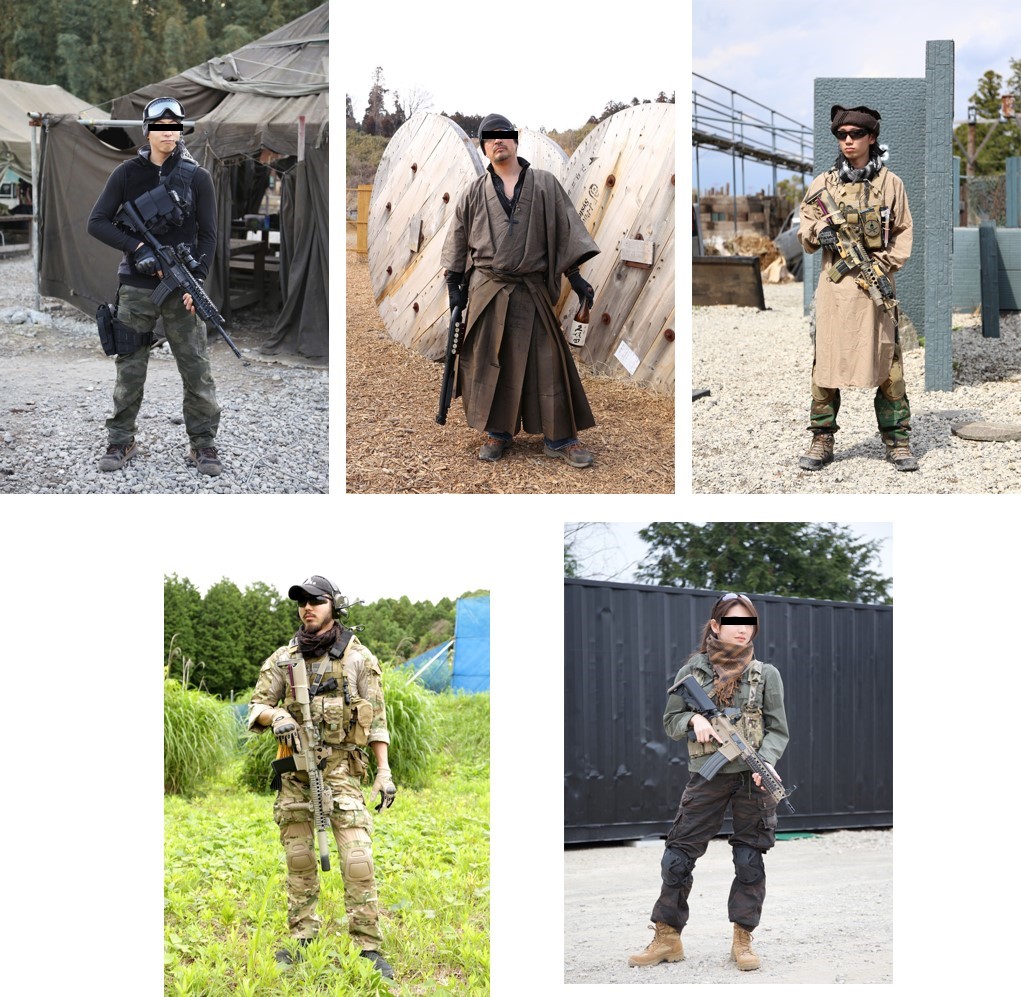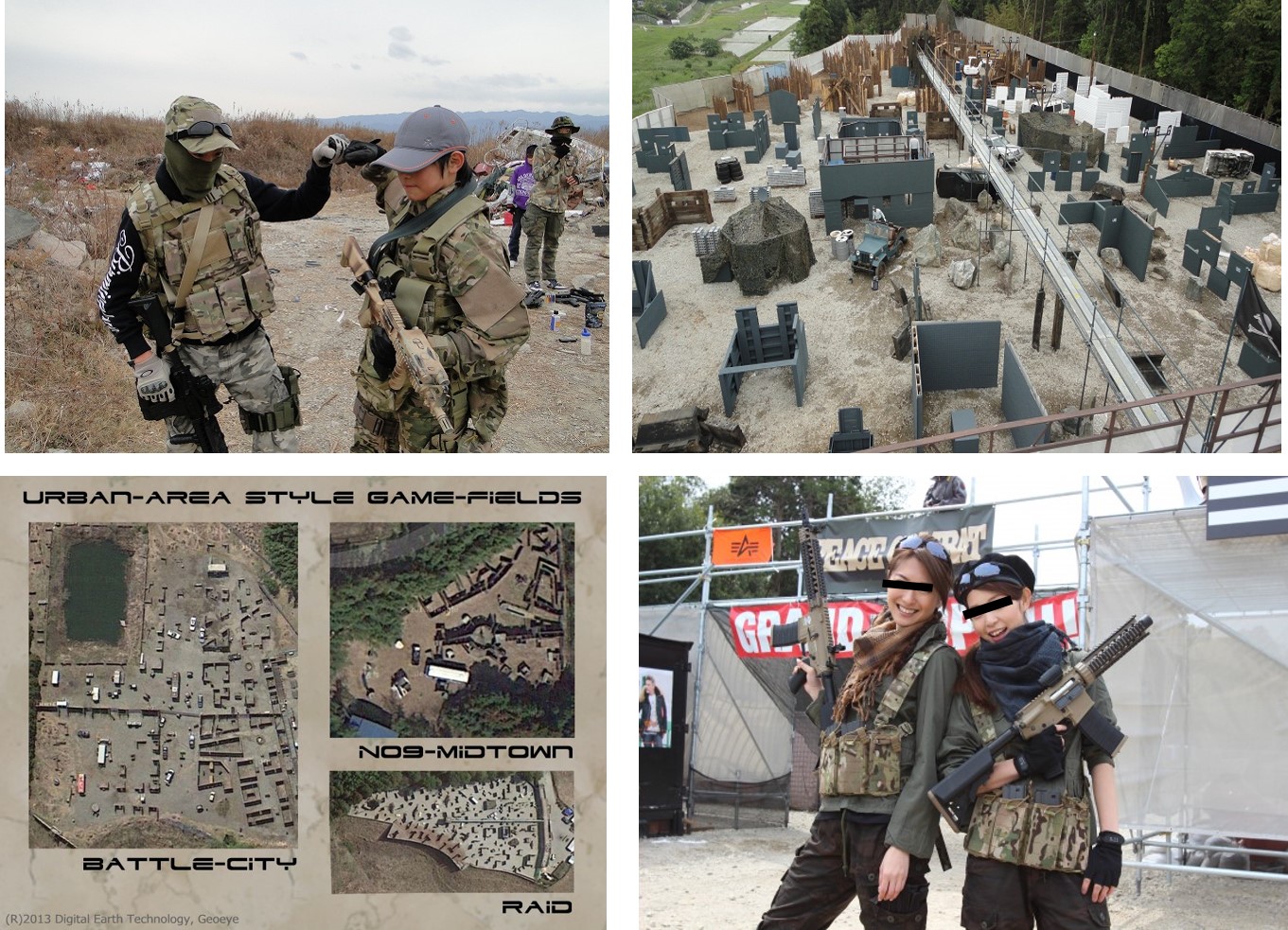For a country as peaceful and gun free as Japan the recent boom in popular of an activity which revolves around shooting other people may seem odd in the extreme. However, the roots of the popularity of Sabage (short for “survival game”, otherwise known as airsoft in the West) actually do fit in to the pattern of Japanese hobby booms quite well.
Sabage is played year round in a growing number of facilities throughout the country. Both urban and rural locations are available with the majority located just outside of major cities. Sabage is played by teams of people armed with electric and gas powered replica firearms shooting high velocity, biodegradable, hard plastic pellets. There are a number of different genres of games like capture the flag or elimination which change the goals and rules of play. Most players dress in military camouflage though some do prefer, especially here in Japan, to go with a more exotically styled and unique look. Each round of play can last from a few minutes to hours at a stretch and can involve hundreds of players per side.
Sabage originated as an offshoot of the paintball boom which happened in the West in the 80’s. In Japan paintball never really took off, mostly due to it being so messy and the weapons not looking very “cool”. However, replicas of real guns and actual military equipment (clothing, camo, sights, accessories, etc.) and the more real feeling of playing with pellets as opposed to paint balls found a strong resonance among Japanese players. Since the 80’s Sabage has existed as a semi-fringe outdoor sport played by a handful of people at a small number of facilities around the country. From the mid-2000’s, however, Sabage has exploded in popularity here in Japan and now boasts hundreds of facilities and tens of thousands of regular player. And it keeps getting bigger every year.
Sabage strikes a cord across a spectrum of Japanese hobbies and interests. The attention to detail and accuracy in the replication of weapons and accessories appeals to a sense of Japanese perfectionism. The clothing worn, camouflage and military style, stands outside of the mainstream of fashion and acts as a strong differentiator for those involved in the subculture which is always an important point for those living in homogenized Japan. The necessity of learning and study being a powerful key to winning also resonates in a culture with such rooted correlation between education and success. Playing outdoors, in the midst of nature, also holds a powerful appeal for Japanese players. All of the above and, of course, the empowerment and adrenaline of battle, simulated though it is, has proven to be a heady mix.
Players come from all walks of life, both sexes and all ages. The recent boom in Sabage popularity has seen an influx of new players from the cities as groups of friends, fans of the recent numbers of Sabage anime/manga, coworkers, and even couples come out to take part. Starting out in Sabage can be expensive. A high end replica rifle can cost more than 35,000 yen (approx. 350 USD) with clothing and accessories adding much more to that total. Most facilities have rentals available for first timers and those who get into Sabage tend to gradually work their way towards more expensive weapons and items as they learn from playing what their individual styles are and needs may lay.

The internet and online shopping has played an important role in driving the recent boom in Sabage popularity. There are endless websites, blogs and videos on YouTube which provide entry into the activity and an active community of fellow players to trade stories, tips and sell goods. A number of Sabage specialty stores are also available in cities across Japan. The most famous being Echigoya in Tokyo (Akihabara, Shinjuku and Yokohama). Weapon makers like the world renowned Marui dominate the Japanese and overseas Sabage/Airsoft markets. There are even a growing number of Japanese domestic firms, such as Volk Tactical, who are producing weapons accessories (scopes, tactical gear, camouflage, etc.) on par or better than overseas makers.
My First Sabage
I first became aware of Sabage while shopping in the electronic/otaku mecca of Akihabara. While walking around I saw a store advertising not computer parts or anime goods but guns. Living in Japan the only guns one sees are on TV or the occasional police officer holstering a tiny .38 sub. When I walked into the store it was like something out of a Hollywood movie. Perfect replicas of every conceivable rifle from militaries around the world lined the walls. There were multiple showcases with hundreds of handguns and a vast space with military gear (including real latest gen night vision and thermal imaging goggles and scopes) alongside racks of camo clothing. It took some time to square this scene and the dozens of shoppers browsing around with an image of a peaceful, gun free Japan. Talking with the very helpful staff I soon discovered what all of this gear was for and decided to try out Sabage myself.
I choose a Sunday to drive out with a small group of friends. On the day, however, the temperature was expected to reach 38C and my friends dropped out. So, jumping on the train I made my own way to a facility which had been recommended to me, Battle Union Tokyo, close to Chiba City just on the outskirts of Tokyo proper. Despite the midsummer heat there were close to 150 players ranged around the “safe zone” are (preparation and waiting area for use before and between games). I signed in, got my battle area map, team designation arm bands, speed checked my rifle and handgun (in Japan the law requires replica guns to have no more than 1 joule of energy delivered to each round to prevent them from being truly dangerous weapons and the possibility of their use in the commission of crimes) laid out my gear and waited for the first game to start.
The rules of Sabage are fairly simple. Most importantly wear your eye protection and team ID markers at all times. Second, the game operates on an honor system so when hit you have to yell out “hit” and get out of the way with your arms held high (or you will be shot again and again by a lot by angry players on the other side and your own). Third, friendly fire is not appreciated so check your targets before opening up on full auto on anything that moves. And finally, have fun…after all, this is not really supposed to be a real war.
The facility I visited ran a full day all comers welcome event starting at 9am and running through 5pm. Each game was typically 30 minutes with 15-20 minutes of combat and a 10 minute break before the start of the next round. Each round was a different game type (capture the flag, team elimination, item seizure, survival and strangely enough “Taliban versus PMC”) with the team starting points varied per game.
From the first game I quickly learned a few valuable lessons about Sabage and small unit tactics. Even when playing in games where you could “come back to life”, by running to your team start point after being hit, getting shot with high velocity pellets hurts and is something to definitely be avoided. With so many people on the opposing team, usually more than 50, surviving a game without getting shot can be very challenging. One thing I learned early was that the more I played like I was an 80’s action star the faster I was pelted by loads of bullets. Surviving the game means taking cover, planning your movements, using the terrain and fake buildings/obstacles around you and being constantly aware of your surroundings. As this was my first time out I was not really able to take full advantage of some of the more esoteric small unit tactics which my new friends on the team talked about during the breaks like anticipating and funneling the enemy into kill zones, coordinated group movements and formation deployment on contact. A number of years playing FPS games online didn’t hurt, though.
By the end 8 hours of combat on a hot summer day I could definitely understand the appeal of Sabage. The weapons and gear were meticulously replicas and exceptionally well made. The attention to detail in gear and tactics was very Japanese. The players were fascinating in their variety and backgrounds. The comradery which emerged between team members was quick, natural and sincere. Running around in nature for the better part of a day was an excellent escape from urban living. Simulated combat exceeded the thrill of more normal sports and having real consequences for being hit (pellets definitely leave a mark) led to a hyper accelerated learning curve.
I definitely left the first day a much better player than I had started. And finally there was an edginess to playing at war in a country like Japan which idolizes peace. Most of the players I met were not advocates of war, of Japan rearming or of a more aggressive stance for Japan in the region or the world. That said, there was a powerful understanding that by playing at war they were standing outside of the mainstream of Japanese culture. Some in Japan have argued that the growing popularity of Sabage is indicative of a growing military mentality in Japan. Having experienced Sabage in Japan first hand I would agree. Sabage is not for the weak at heart. It is not for the NEETs or “herbivore men” that have been all of the talk in Japan over the past decade. Sabage is most reminiscent of “physical culture” movements of the past with, of course, its own Japanese twist. The growing popularity of activities like Sabage may well auger a shift occurring beneath the surface of mainstream Japanese culture towards a more assertive and physical norm.
Culture is, of course, an always shifting mosaic of the desires, fears and drivers of its participants. In Japan the culture of hyper kawaii is widely seen as having peaked by leading commentators here. What comes next may well be an amalgam of more aggressive subcultures like that surrounding Sabage.
Regardless of how the tectonics of Japanese culture shift over the coming year’s one thing is certain, Sabage has at least one new player. See you on the battlefield!
【ご意見ご感想がございましたら、こちらのメールアドレスまでご連絡ください。: goiken@sugataresearch.com】

